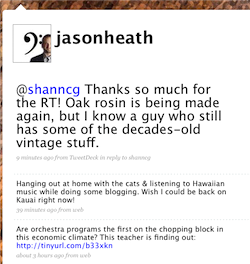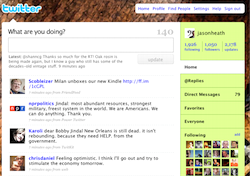
I’ve been an enthusiastic Twitterer for the past two years (you can find me at twitter.com/jasonheath), learning about the service through the numerous tech podcasts that I consume like digital candy, and while I initially resisted the idea of getting on myself (another service to update….great….and who would I tweet to?), once I got into it I never really looked back, realizing that it could function as a mini-blog within my main blog.
For the first year (or even more), I basically tweeted to myself, not caring too much about what was happening in the “Twitterverse” per se, but using the service’s ability to provide a more regular update stream within my main blog and serving as my Facebook status updater. These two functions were reason enough to keep using the service.
Twitter – My Real Blog
As my life kept churning past several important milestones (marriage, vacation, school) a funny thing started to happen: all these little random bits of 140 character digital scraps I’d been leaving all over the place started to make sense to me. They actually weren’t random….well, they were random, but…they had actually become my blog. I don’t mean doublebassblog.org, I mean my blog, my own personal blog. My bass blog had long ago morphed into a business and community site, and looking through the archives over the past five years of blogging left me with a strong impression of what I’d published but not much about the actual ups and downs of my life. On the other hand, my Twitter feed, despite all its silly little quips about “eating burritos,” “petting cats,” and “going for a run” was probably the closest thing I had to a diary.

Getting into the Community of Twitter
It probably wasn’t until I picked up an iPhone (I skipped the first generation of the super phone and got a 3G phone in July of 2008) that I really started to read what others were tweeting about on Twitter. I’d built up a lot of Twitter friends–being on since 2007 helped with that–but I hadn’t really done a lot of following along with Twitter happenings.
I quickly started to realize a few things:
1. Twitter was more than what I was eating for lunch – I’d been using Twitter as a way to keep a personal blog, but other folks were using it for much more than that, using it as an amalgamation of instant messaging, email, and blog functionality. It was all of those things and yet none of those things, something that combined previous technologies in a way that rendered them entirely new.
2. Twitter was a wicked way to share links – Discovering Twitpic was a revelation for me, and I quickly began tweeting photos of things I was doing, loving how it brought another dimension to my tweets. But that wasn’t all–I couldn’t help but notice how many people were putting links into their tweets, and many of these links were pretty darn cool! I wouldn’t be very likely to recieve these links from these particular people were it not for Twitter, and I began to follow more and more interesting linkers. As I did this, I began putting out more links of my own in my tweets and getting positive responses from followers. This was cool!
3. Twitter was kind of like the next generation of RSS – Is RSS dead? I often tell my less tech-obsessed friends that blogs are dead, and they look at me with incomprehension–they’ve only recently figured out what a blog actually is, and the concept of RSS was still hazy and confusing. What am I talking about, blogging is dead? Don’t I have a blog? Isn’t this a stupid thing to think?
Blogging is Dead?
I don’t mean, of course, that blogging is really dead, but I do think that the notion of using an RSS reader to aggregate news is quickly shifting to social sharing sites like Twitter and Facebook. For example, I now subscribe to about a dozen Twitter feeds from major news sources, and I find that the links I get are real-time and easier to parse than in an RSS reader. Things tend to get clogged up in an RSS reader, like stacks of moldy old newspapers, while Twitter is a stream of information that I can dip into, real-time, whenever I want to see what’s happening in the world.
Here are some of the news streams that I subscribe to through Twitter. If you click on many of these (including the New York Times) you’ll find that they actually have many feeds for different subjects, so you can follow NYT Science, NYT Books, etc.:
Some of these news sources just facelessly pump out their stories on Twitter, but others (especially the Chicago Sun-Times!) actually are real people who’ll interact with you.
The Power of Twitter
As I’ve gotten more into the complete Twitter experience, I’ve really started to get more out of it. There’s something to this–I just can’t quite articulate it, and judging from the countless other posts out there like the one you’re reading right now, many people feel the same about it as I do. This is something new and something powerful, and I’d encourage you to experiment with it and keep your eyes open to see how this develops in the next 1,2,5, and 10 years.
Classical Music Twitterers
Though still small (we classical music people always seem to be slow to the table with these new technologies), there is a rapidly growing community of classical music organizations, performers, bloggers, and fans on Twitter. This presence, I firmly believe, will ultimately be much more powerful than any mailing list could possibly be, and it’s great to see organizations like the Chicago Symphony (with whom I’ve directly communicated through Twitter) embracing this new technology in such a progressive fashion:
- Chicago Symphony
- Toronto Symphony
- Aspen Music Festival
- Greg Sandow
- Campbell Vertesi
- Patty Mitchell – oboeinsight
- Chris Foley – Collaborative Piano Blog
- Drew McManus – Adaptistration
- Classical Music News
- Chicago Lyric Opera
- Naxos
- Stan Haskins – Glued to the String
- Joe Lewis – San Be Ji
- Matt Wengerd

TweetDeck and Parsing Twitter Data
One of the problems of Twiter is that it can feel like a disorganized fire hose of random information, and, to be honest, that’s kind of what it is! Finding some way to parse all this data can really add a lot of functionality to this service, which is where, for me, TweetDeck comes in.
TweetDeck allows you to organize people you follow into groups, search for particular keywords, and even see what topics are particularly hot on Twitter at that moment. Hugely useful.
Twitter clients I use
I currently use TweetDeck (free) on the desktop and Tweetie ($2.99) on the iPhone, which is a truly awesome Twitter interface for a mobile device–highly recommended.
I’ve also used the following programs, with various degrees of success:
- Twitterific (iPhone)
- Twinkle (iPhone)
- Twitterfon (iPhone)
- twhirl (desktop)
Other Classical Music Twitterers?
Are you a classical music person on Twitter? Let me know, and follow me at twitter.com/jasonheath!
Bass News Right To Your Inbox!
Subscribe to get our weekly newsletter covering the double bass world.

I really like the Twitterfon client for iPhone & wish it had a desktop version.
City Opera Musicians and Management Reach Agreement
Orchestra Musicians say agreement too concessionary but vote to approve;
2012 Opera season salvaged
New York City—Thursday, January 19, 2012 – After months of tense negotiations resulting in a lockout of musicians by management, the full New York City Opera orchestra voted today to approve a three-year contract. This approval allows the 2012 season of the venerated 68-year-old company to proceed.
“This settlement is far from ideal,” said Tino Gagliardi, president of Local 802, AFM, in response to the proposal, “but our membership has voted to move forward in the hopes that the deep concessions they have accepted will allow the Opera to begin to come back to fiscal health, expand its audience and rise from the ashes. Our great hope is that going forward, management can begin to make better decisions—increasing revenues and allowing for an eventual level of compensation that truly respects these A-list performers and honors the reputation of the ‘People’s Opera’ as a world-class ensemble.”
The new contract does prevent General Manager George Steel from executing his original plan to dismantle the professional company and turn salaried performers into itinerant freelancers without benefits. However, as is evidenced by the agreement, the musicians have demonstrated significant flexibility throughout negotiations regarding issues such as wages and health care.
The agreement establishes a Labor-Management Committee to address artistic, planning and fundraising issues. The committee was proposed in response to Steel’s management decisions, which have resulted in a reduction of the company’s performance schedule from more than 100 performances per year down to the 16 planned for the 2012 season. Audience growth has also been an issue, with Steel’s tenure characterized by low ticket sales (down 74%) and falling subscriptions (down 84%). Musicians also believe that Steel’s decision to abandon the Opera’s home at the David H. Koch Theater at Lincoln Center, remove the Music Director and begin performing only at smaller venues is the opposite of the bold vision needed to truly save the organization. They advocate investing in growth, as the Metropolitan Opera and Kennedy Center have done.
Said Gail Kruvand, Chair of Local 802’s City Opera negotiating committee and double bassist,
“After losing our home at Lincoln Center, our Music Director and over 80% of our wages, this contract is a bitter pill to swallow. With that said, the orchestra is prepared to perform as the professionals we have been recognized as for the last 68 years.”
Rehearsals have begun for the NYCO’s La Traviata – opening February 12th.